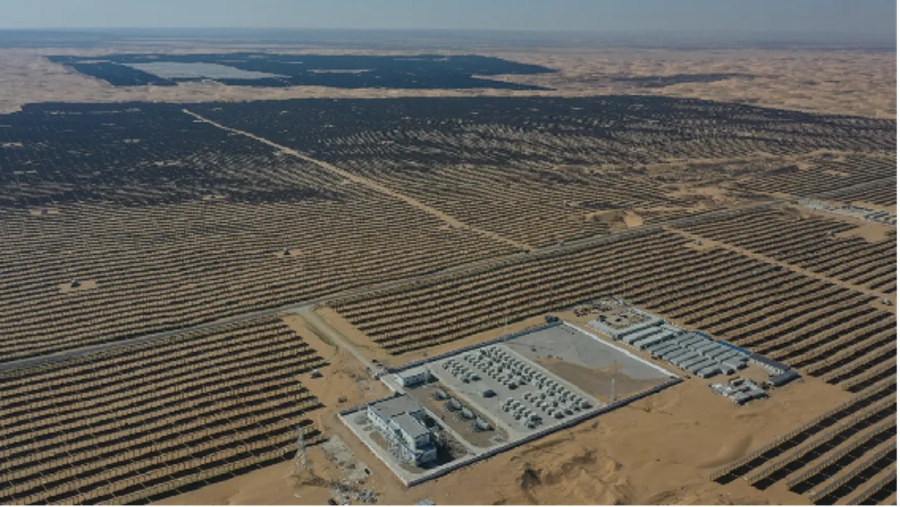ESS uses iron flow battery deployments to adapt to new customer requirements

Oregon-based flow-battery developer ESS Inc. says it is learning from its existing deployment projects to scale up and modify its long-duration energy storage (LDES) technology to meet a wider variety of requirements. The combination of safety inherent in its iron and salt water electrolyte chemistry and improving costs are making the once-novel system more attractive.
In May, the company commissioned its Energy Warehouse LDES system at Amsterdam Airport Schiphol as part of an evaluation project to replace diesel-fueled auxiliary power generators that supply electrical power to aircraft while they are at the gates with electric systems. The battery powered units are recharged from a containerized Energy Warehouse system deployed on the apron.
The ESS installation at Schiphol is a demonstration project, but could be expanded throughout the airport, which has a goal of decarbonizing all of its facilities’ and grounds operations’ energy use by 2030. The airport participates in the European Union-funded TULIPS consortium of airports working to incorporate renewable energy into the aviation sector. The Schiphol airport is installing solar panels at numerous locations, meaning flow batteries could soon be storing renewable energy there.
Hugh McDermott, ESS’ senior vice president of business development and sales, told pv magazine USA that lessons from the Schiphol project, as well as other deployments in other industries, has validated its flow battery concept and is informing the company’s future product development.
“[Schiphol] came to us and said, ‘Hey, your water-based battery looks great. We can put it right there on the taxiway and not have to worry about a nightmare scenario of lithium-ion batteries and all that jet fuel.’ So, safety was the number one concern for that application.”
The chemistry of ESS’ flow battery electrolyte is essentially salt water and iron. The company says it is transparent about this chemistry because it differentiates itself on the design of its battery stack and the automated process for producing them. This is where the patents and intellectual property are.
Flow battery chemistry is an issue because many of the developers competing for LDES applications are looking for alternatives to vanadium-based electrolytes. Vanadium is generally regarded as one of the most effective elements to use in flow batteries because of holds a high charge level and doesn’t degrade as quickly as other materials. However, vanadium is expensive and tends to come regions with political difficulties or stability issues, such as China, Russia and South Africa.
McDermott said the relatively simple chemistry of ESS’ iron-flow batteries and its closed-loop design keep production costs down while reducing degradation over tens of thousands of charge cycles.
“What that does in terms of the engineering implications is that the balance of a product is off the shelf, Home Depot-type equipment,” he said. “So, it’s PVC plumbing and it’s a plastic tank. There’s nothing exotic about sourcing those materials. The pumps and motors that operate the variable speed flow drives are off the shelf items that don’t need to be specially coated. So, other words, we’re trying to drive down to commodity items for everything other than the battery module itself, which is really where we add value to the product.”

ESS’ engineering efforts go into scaling the battery and adapting it for specific customers. The company had “double-stacked” its original Energy Warehouse design to create an Energy Center for larger industrial and utility-scale LDES requirements. However, the real challenges are in adapting the technology for an expanding range of industries.
“A battery on its own is an incomplete solution to any customer,” McDermott said. “It needs an inverter and it’s going to need a control that’s going to determine what you want the battery to do. Integrating with those different ecosystem components is a continuous learning process for us.”
There are different inverters and different controls each with its own language. McDermott said one sort of broad category of learning is that no two inverters or controllers behave exactly the same is there’s a “dark art” to how they do their algorithms internally. Then work is required to sure the response is what the customer wants. The good news is that there seems to be growing interest for flow batteries as an LDES solution from many quarters. The bad news is that each of these has its own set of requirements with many variations.
For example, ESS has been working with the U.S. Department of Defense on adapting its iron flow technology for microgrids. One of the characteristics of a military microgrid is that it be “blinkless.”
“Blinkless is a term of art, meaning that if I lost the grid power or if I switch from a generator to a solar source or to some grid source and back again and not even notice that the lights flicker,” McDermott said. “So, it has to be a fast response. One of the perceptions out there in flow batteries is that they can’t be a fast response battery. We’ve done that for the military. We’ve done it for industrial customers to straight repeatedly. That’s cool, right? Flow batteries are not slowest piece in the equation.”
ESS has attracted both investment and customer orders from Honeywell. In August, the company secured $50 million in funding from the U.S. Import-Export Bank’s Make More in America Initiative to expand its manufacturing operations. McDermott said these investments and additional commercial projects will help underwrite ESS’ engineering efforts to expand iron flow battery acceptance.
Other companies are investing in iron-based flow battery technologies with different approaches and proprietary technologies. Last May, Germany-based CMBlu Technologies sold its SolidFlow battery system to Mercedes Benz to provide storage for the PV system at one of its factories. The company also has active projects with WEC Energy Group in Wisconsin and at the Salt River Project in Arizona.
From pv magazine USA.













